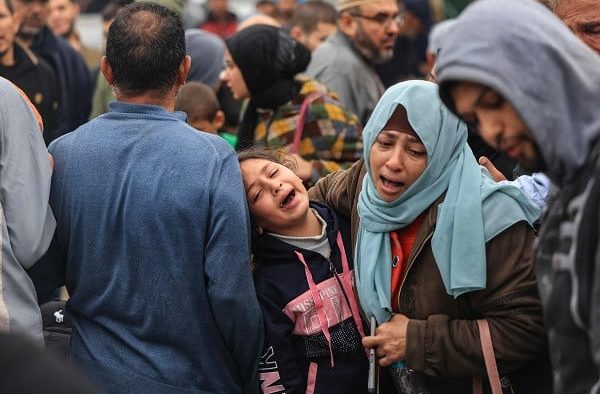Hamas fighters battle Israeli invasion forces in southern Gaza

After demolishing what it described as “terrorist infrastructure,” the Israeli army declared on Tuesday that it had encircled the Jabalia refugee camp in Gaza, according to Al Jazeera.
Since October 7, Israel has repeatedly attacked the largest camp in Gaza, Jabalia, with the result that hundreds of people have died and that infrastructure has been destroyed.
The most recent reports stated that Israel had increased its strikes throughout the Gaza Strip, especially in the vicinity of hospitals and in the southern part of the beleaguered enclave where the ground operation was being stepped up.
Al Jazeera reported that “Israel’s indiscriminate bombardment of Palestinian civilians in southern Gaza has reached new depths,” citing the head of the Norwegian Refugee Council.
“This has been a very, very tough night for Palestinians living in the Gaza Strip, particularly for residents in Khan Younis city and Rafah city, and the 1.5 million evacuees who have been pushed south by the Israeli military to avoid getting bombed in northern Gaza,” said Hani Mahmoud, a reporter for the Qatar-based media house from Gaza, in reference to last night’s attacks.
Khan Younis under intense attack these moments pic.twitter.com/D0NpzORr4m
— Gaza Report – اخبار غزة (@gaza_report) December 5, 2023
He said that since early yesterday evening, there have been reports of constant severe artillery shelling, airstrikes, and mass bombing.
“On the eastern side of Khan Younis, the great majority of residential buildings and public spaces, including businesses, schools, hospitals, and medical centers, have been totally devastated. People were also given the order to flee while there was intense bombardment in the middle of the night and early this morning.
Shots were fired at ambulances attempting to reach the eastern side of Khan Younis, Abasan al-Kabira, and Bani Suheila. This made it extremely difficult to evacuate injured patients or recover the bodies of those who had died over night.
Tuesday saw Hamas resistance fighters fighting Israeli troops in the southern Gaza Strip as the Israelis continued their advance into the confined area, warning that a “even more hellish scenario” was developing for the residents who were trapped.
Although Israel’s army had previously only dropped leaflets on parts of the south advising Palestinian inhabitants to evacuate, the army has now expanded its attack beyond the territory’s northern borders.
According to witnesses who spoke to AFP, Israeli tanks, armored personnel carriers, and bulldozers were spotted on Monday close to Khan Yunis, a city in southern Gaza that is home to many inhabitants who fled their homes further north during the conflict.
Following an Israeli airstrike, an AFP journalist in Rafah, close to Gaza’s border with Egypt, observed smoke billowing late on Monday from buildings in southern Gaza.
The army issued a warning on Monday, stating that the main route running through Khan Yunis’ east and north “constitutes a battlefield” and that it was conducting “aggressive” action against “Hamas and other terrorist organizations.”
Through Telegram, Hamas asserted that its militants had hit a tank and two people carriers close to Khan Yunis.
Along with the Israeli military’s claim that missile warning sirens sounded in Beersheba, southern Israel, its military branch also claimed to have fired rockets against the town on Tuesday.
International relief organizations have issued a warning that as Israel’s offensive continues deeper into Gaza, inhabitants in the heavily populated area are running out of options to escape.
According to UN humanitarian coordinator for the Palestinian territories Lynn Hastings, “there is nowhere left to go and nowhere is safe in Gaza.”
“If possible, an even more hellish scenario is about to unfold, one in which humanitarian operations may not be able to respond,” Hastings stated in a statement.
Approximately 15,900 individuals have died in the Gaza Strip as a result of the conflict, with women and children accounting for almost 70% of the deaths, according to the Palestinian Ministry of Health.
Abu Jahar al-Hajj, a resident of Rafah, a city close to the Egyptian border, described an airstrike close to his house as feeling “like an earthquake”.
“Pieces of concrete started falling on us,” he stated.
Further north, in Deir al-Balah, Walaa Abu Libda claimed to have taken refuge at a hospital, but her four-year-old daughter was still buried beneath debris.
“I don’t know if she is dead or alive,” Libda said. According to UN estimates, 1.8 million people—roughly three-quarters of the population—are internally displaced in Gaza.
The Israeli army reported on Tuesday that three more troops have lost their lives in fighting in the Gaza Strip, bringing the total number of troop fatalities there to 78.
On Tuesday, the Israeli army refuted claims that it instructed the WHO to evacuate a relief warehouse in southern Gaza within a day in order to prevent ground operations from rendering it useless.
The IDF had notified Tedros Adhanom Ghebreyesus, the head of WHO, “that we should remove our supplies from our medical warehouse in southern Gaza within 24 hours,” he wrote on X on Monday.
As operations go south, Israel’s main ally, the United States, has warned it to take additional precautions to prevent civilian casualties.
Israel asserted on Monday that it was looking for assistance from humanitarian organizations to upgrade infrastructure in Al-Mawasi, a small seaside neighborhood in Gaza, rather than forcibly evicting Palestinian inhabitants from their homes.
Israeli military spokesman Jonathan Conricus stated, “We have asked civilians to evacuate the battlefield and we have provided a designated humanitarian zone inside the Gaza Strip.”
One of the officers continued, “Hopefully it (the ratio) will be much lower” in the upcoming phase of the conflict.
In order to do this, the officials stated, the army is tracking population movements within the Gaza Strip and issuing orders for evacuation using sophisticated mapping software.
The system uses AI, aerial surveillance, word-of-mouth from local sources, mobile phones, and other signals to keep an updated map of population concentrations throughout the region.
However, in a place where access to electricity and telecommunications is patchy, the UN Humanitarian Office (OCHA) has questioned the practicality of such a tool.
According to Palestinian telecom company Paltel, all mobile and phone services were unavailable in Gaza on Monday “due to the cut-off of main fiber routes from the Israeli side.”
Global network watchdog Netblocks verified on Tuesday that Gazans were facing “a complete loss of communications.”
The most recent fighting came after a truce brokered by Qatar last Friday, which witnessed the release of several Israeli and other inmates in return for Palestinian detainees.
At least 137 prisoners are reportedly still being held in Gaza, according to the Israeli military, but Hamas has said that no more releases will take place until a long-term ceasefire is reached.
Because of the war and the regular gunfire exchanges between Israel and Hezbollah across Lebanon’s border, there are fears of a wider regional warfare.
The Israeli military declared on Tuesday that it had attacked Hezbollah locations with its fighter jets in retaliation for missiles into Israel on Monday from Lebanon.
More than 250 Palestinians have been killed in the Israel-occupied West Bank since the start of the conflict, according to Palestinian authorities, who have also reported an increase in violence

I am a dedicated student currently in my seventh semester, pursuing a degree in International Relations. Alongside my academic pursuits, I am actively engaged in the professional field as a content writer at the Rangeinn website.








